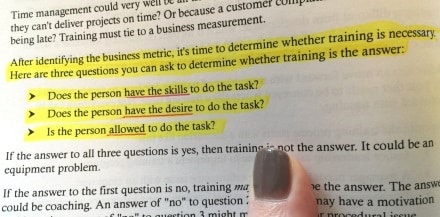Is a Training Meeting the Best Approach
(Editor’s Note: Today’s post is an excerpt from my book, “Essential Meeting Blueprints for Managers.” The book is available on Amazon in hard copy and Kindle, in the iTunes store, and directly from the publisher.)
There an important step to the training process – answering the question “Does it need to be a meeting?” Given the number of meetings out there, it’s amazing to me how many people don’t ask this question. We’ve decided training needs to be conducted. What’s the most effective way to deliver the training?
There are two key elements to consider when trying to decide if the training you’re planning should be conducted during a meeting: message and medium.
Message is the point you’re trying to get across. What do you want people to come away with from your training?
For example, if you’re a restaurant manager trying to teach your servers how to open a bottle of wine, a training meeting would be perfect. Employees can see a demonstration and have the chance to open a bottle of wine to practice.
On the other hand, if you want all of your employees to learn the basics of a social media platform, it would be possible for you to ask them to view a video, create an account, and connect with you before the next team meeting. Did the employee learn something? Yes. At the point they connect with you, they’ve learned how to set up an account. But it didn’t take a meeting for that type of learning to happen.
Training meetings are perfect for topics that involve complex discussion or multiple steps. The training agenda allows for discussion and practice. While it can be done, straightforward subjects or activities might not require a meeting. It might be possible to use another method, which brings me to the second consideration.
Medium is the communication tool you use to get that point across. It might be PowerPoint, video, lecture, etc.
A new hire employee needs to learn the organization’s ethics policy. The company has prepared a pre-recorded webinar with the CEO and human resources director talking about the policy and common scenarios the employee might face. Both during and at the end of the webinar, the employee answers questions regarding the information presented. The employee is learning and the company is getting confirmation that the employee understands the material. But a meeting did not occur.
A nonprofit animal shelter invites a veterinarian to speak on the signs to look for in feline leukemia. Did learning take place? Yes. The staff in attendance learned the signs they need to be aware of when working with cats. And in this case, a meeting did take place.
Now, is it possible that the animal shelter staff could have read a book or watched a video and still learned the information? Maybe. But let’s say the veterinarian is the local expert on the subject and it was the group’s only chance to hear from the expert. That would be a good reason for a meeting. Or if the information needed to be presented to everyone quickly versus letting each person learn at their own pace by reading a book.
So for those times when physical presence or timing is key, training meetings are a good option.
The last element to consider when it comes to whether or not to hold a training meeting is what I’ll call the entertainment factor. Bringing people together can be fun. You can add non-meeting elements to the agenda like teambuilding and recognition. So if the message is a bit on the dull side (you know what classifies as dull in your industry), it might make sense to create a training meeting even if it’s not necessary and insert some other things into the agenda to make it more engaging.
The caution with doing this is that the fun part of the agenda cannot overshadow the training part. It’s not a fun meeting with a little insertion of training. It’s a training meeting with a little infusion of fun. If the fun, entertaining part overshadows the training, it’s possible that people will leave the meeting happy but with no clue what they were supposed to learn. The conversation goes something like this:
Employee: “Wow! What a great meeting. You should have heard him/her.”
Manager: “What did they talk about?”
Employee: (Insert sound of crickets here) “They were just so funny!”
I’ve actually seen this happen. The company needs to train employees on a very serious topic. But they also wanted to give the employees an enjoyable training experience. So the trainer they hired was humorous and entertaining. He was also very smart and knew the subject matter well. Don’t confuse being funny with not knowing the material. But the problem occurred when the trainer spent more time trying to get laughs than convey the important material. Subsequently, the employees did attend training but didn’t learn everything. The company was forced to hire another trainer to conduct more focused sessions a second time.
Choosing to conduct a training meeting is an important decision. Most companies already have plenty of meetings. A training meeting adds another meeting to people’s busy schedules. Calling a training meeting when it’s not needed can cause people to tune the message out. So instead of employees learning, they are walking in/out of the session, texting their BFF or planning their next vacation while the training is supposed to be taking place.
As much as we want to think it’s only the content that counts, message and medium allow the presentation to be engaging and understood.
P.S. I hope you can join me and SHRM tomorrow at 3 p.m. Eastern for a #NextChat about business meetings. Bring your stories, peeves and tips – it’s sure to be a lively discussion! If you’re not familiar with Twitter chats – check out this video about the benefits!
5